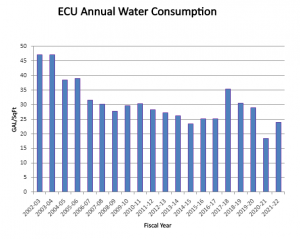Water Conservation
ECU takes water conservation extremely seriously and has worked quickly to make water conservation a priority on all campuses. Recent droughts in the area have brought into clear focus the need to conserve water, and in response, ECU is addressing the issue in a variety of ways.
When irrigation is necessary, ECU uses an advanced system equipped with a weather station that determines how much water is lost in a day. The irrigation system is then able to deliver the precise amount of water needed to the landscape, effectively eliminating over watering.
ECU Facilities Services has worked to reduce water usage in campus buildings for the past five years. In that time the university has seen water consumption decrease 33 percent annually per square foot. Apart from the traditional water-saving initiatives, such as installing low-flow faucets, toilets, and shower heads across campus, ECU is working on more creative ways to save water.
Reclaimed Water
This is a photo of the water reclamation system at Coastal Studies Institute. Water is captured from the roof of the facility then piped down through a filtration system. Once the water has been treated, it is transferred into four 12,000 gallon underground storage tanks. Finally, the water in the tanks is connected to the indoor plumbing system and used to flush toilets and urinals.
Indoor Plumbing Fixtures
ECU Facilities Services has worked to reduce water usage in campus buildings through traditional water-saving initiatives, such as installing low-flow faucets, toilets, and shower heads across campus.
For example, over 20 academic and administrative buildings have been completely upgraded with low-flow fixtures. In addition, West End Dining, Dowdy-Ficklen Stadium, Clark-LeClair Stadium, and CRW facilities now have low-flow fixtures. Nearly all the dorms have also upgraded to low flow shower heads and, in the Health Sciences Building alone, ECU has replaced 137 toilet valves with 2-flush type.
Trayless Dining Program
Did you know that Dining Services has been trayless since 2007? By dining trayless, you have helped positively impact the waste stream. Dining trayless minimizes food waste, conserves energy and water, and reduces the amount of cleaning chemicals entering the sanitary sewer.

| Year | Water Cost Avoided | Square Foot Cost ($/kGal) | Water Intensity (Gal/GSF) | Water Intensity Change |
|---|---|---|---|---|
| 2002-03 | -- | $5.12 | 51.43 | -- |
| 2003-04 | $105,628 | $4.87 | 47.04 | -9% |
| 2004-05 | $388,649 | $5.66 | 38.52 | -25% |
| 2005-06 | $365,955 | $5.44 | 38.99 | -24% |
| 2006-07 | $709,569 | $5.67 | 31.57 | -39% |
| 2007-08 | $815,644 | $5.74 | 30.25 | -41% |
| 2008-09 | $997,608 | $6.45 | 27.70 | -46% |
| 2009-10 | $931,172 | $6.64 | 29.64 | -42% |
| 2010-11 | $969,942 | $7.07 | 30.39 | -41% |
| 2011-12 | $1,220,903 | $8.05 | 28.18 | -45% |
| 2012-13 | $1,349,254 | $8.20 | 27.14 | -47% |
| 2013-14 | $1,397,859 | $8.20 | 26.25 | -49% |
| 2014-15 | $1,736,159 | $9.05 | 23.45 | -54% |
| 2015-16 | $1,732,465 | $9.59 | 25.12 | -51% |
| 2016-17 | $1,510,135 | $8.29 | 25.19 | -51% |
| 2017-18 | $730,413 | $6.56 | 35.39 | -31% |
| 2018-19 | $1,114,360 | $7.13 | 30.50 | -41% |
| 2019-20 | $1,366,764 | $8.15 | 29.02 | -44% |
| 2020-21 | $2,526,465 | $10.19 | 18.34 | -64% |
| 2021-22 | $2,271,424 | $10.84 | 23.97 | -53% |
Table 2: $22.2M in cost avoidance since FY2002-03 and 53% reduction in water intensity.